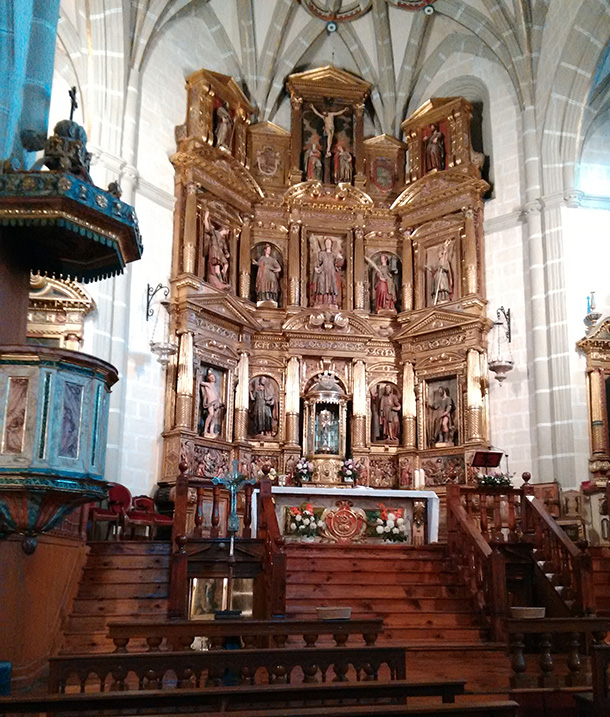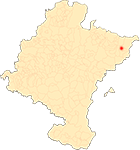Route through the Roncal altarpieces
By Ricardo Fernández Gracia
High altarpiece of the parish church of Uztárroz
Studied by Professor García Gainza, it is the work of the Sangüesa masters Juan de Berroeta and Juan de Huici. The latter, an assembler and architect from Lumbier, carried out an intense artistic activity in Navarre from Tudela to Ituren, and his projects reached as far as Guipúzcoa, where he made the Oyarzun altarpiece. He maintained a close and continuous relationship with the Sangüesa sculptor Juan de Berroeta at partnership , which resulted in the altarpieces of Tabar, Sada, Liédena, San Pedro de Gallipienzo and the present one in Ustárroz. The aforementioned Juan de Berroeta was a sculptor from Sangüesa, whose activity is documented over half a century (1589-1639). He trained alongside his father-in-law, Nicolás de Berástegui, also a sculptor who produced works in Aragon and Navarre, collaborating on numerous occasions with the sculptor Juan de Alli and the assembler Juan de Echenagusia. The last phase of his activity coincides with that of partnership with the aforementioned Juan de Huici, which can be seen in the altarpieces of Liédena, Sada and Uztárroz.
The gilding of the Uztárroz altarpiece was carried out by the prolific master Juan Andrés de Armendáriz, who in 1669 had it appraised by Juan de las Heras and Pedro Bariain, who estimated it at 61,500 reales. Juan Andrés de Armendáriz (1619-1681), son of a painter, has documented gilding work on numerous altarpieces in the capital of Navarre and in numerous towns in the surrounding area. As an easel painter, he is only known for the canvas painted at the request of the city of Pamplona in 1657 to commemorate the co-patronage of San Fermín and San Francisco Javier over the Kingdom of Navarre, which is kept in Pamplona City Hall.
The Uztárroz (Roncal) altarpiece would have been finished by 1635, the year in which Berroeta and Huici appear as creditors of two thousand ducats in the parish's first-prize income. Adapted in plan to the chancel of the church, it stands out for the monumentality of its architecture, made up of a bench, two sections and a top, structured by columns with fluted and grooved shafts and superimposed Ionic and Corinthian orders. The geometric decoration is abundant, based on coffered ceilings, pearls alternating with rosettes and non-naturalistic foliage. To this must be added the multiplication of mouldings on boxes and pediments, thus achieving an early Baroque ornamental profusion. Also typical of this period is the scarcity of reliefs, practically reduced to the bench, in favour of the sculpture in bulk, which takes centre stage, occupying the compartments of the entire altarpiece. The figures of St. Andrew, St. Roch and St. Peter stand out, with their large volumes and expressive heads.
The iconographic programme is dense. On the bench we find the reliefs of Saint Stephen, entrance of Christ in Jerusalem, Saint Mark, the Arrest, Saint John, Saint Matthew, the Adulteress, Saint Lawrence, the Resurrection of Lazarus and Saint Luke. The images occupy the rest of the altarpiece. In the first section there is a succession of images: San Sebastián, San Pedro, San Andrés and San Roque; in the second, San Miguel, Santa Lucía, the titular Santa Engracia, Santa Bárbara and San Nicolás and in the attic San Antón and San Urbicio on both sides of the Calvary.
We cannot fail to highlight the two large coats of arms that crown the interlacing, particularly that of the Spanish monarchy, which integrates the arms of Navarre in the centre, following the custom after the conquest and incorporation of Navarre into Castile. In fact, the execution of the royal coat of arms was a reason for confrontation between the parties over the cost of the altarpiece.
Parish archives of Garde, Vidángoz, Isaba, Uztárroz and Roncal.
file Diocesan of Pamplona. Processes
file General of Navarre. Roncal Notary's Office and Processes
ARDANAZ IÑARGA, N., La catedral de Pamplona en el siglo de las Luces. Arte, ceremonial y cultura, Pamplona, doctoral dissertation sustained at the University of Navarre, 2011. Vid. http://hdl.handle.net/10171/20480
BOLOQUI LARRAYA, B., Escultura zaragozana en la época de los Ramírez 1710-1780, Madrid, Ministerio de Cultura, 1983.
CHOCARRO HUESA, M., "El obispo Juan Rena, mediador y mecenas artístico de la catedral de Pamplona", Príncipe de Viana, 256 (2012), Issue dedicated to: programs of study sobre el Patrimonio Cultural y las artes en Navarra en torno a tres hitos 1212-1512-1812, (coordinated by Ricardo Fernández Gracia), pp. 587-601.
CLAVERÍA ARANGUA, J., Iconografía y santuarios de la Virgen en Navarra, vol. I, Madrid, Gráfica management assistant, 1942.
ECHEVERRÍA GOÑI, P., Polychromy of the Renaissance in Navarre, Pamplona, Government of Navarre, 1990.
GARCÍA GAÍNZA, M. C., Romanesque sculpture in Navarre. Disciples and followers of Juan de Anchieta, Pamplona, 1969.
GARCÍA GAÍNZA, M. C. et alt., Catalog Monumental de Navarra, IV* y IV**. Merindad de Sangüesa, Pamplona, Government of Navarra - Archbishopric of Pamplona - University of Navarra, 1989 and 1992.
FERNÁNDEZ GRACIA, R., El retablo barroco en Navarra, Pamplona, Government of Navarre, 2003.
FERNÁNDEZ GRACIA, R., "Los géneros escultóricos", El arte del Barroco en Navarra, (coord. R. Fernández Gracia), Pamplona, Gobierno de Navarra, 2014, pp. 175-271.
GÁRRIZ, J., La villa de Garde en el Valle del Roncal. essay de una monografía parroquial, Pamplona, Casa publishing house de G. Huarte, 1923.
HUALDE, F., "De cuando los Ezquer cruzaron el charco", Diario de Noticias de Navarra, 18 August 2008. http://patrimonionavarra2.blogspot.com.es/2010/09/18-de-agosto-de-2008.html
MORALES SOLCHAGA, E., "El gremio de San José y Santo Tomás de Pamplona hasta el siglo XVII", Príncipe de Viana, no. 239 (2006), pp. 791-860.
URANGA, J. E., Retablos navarros del Renacimiento, Pamplona, Institución Príncipe de Viana, 1947.












